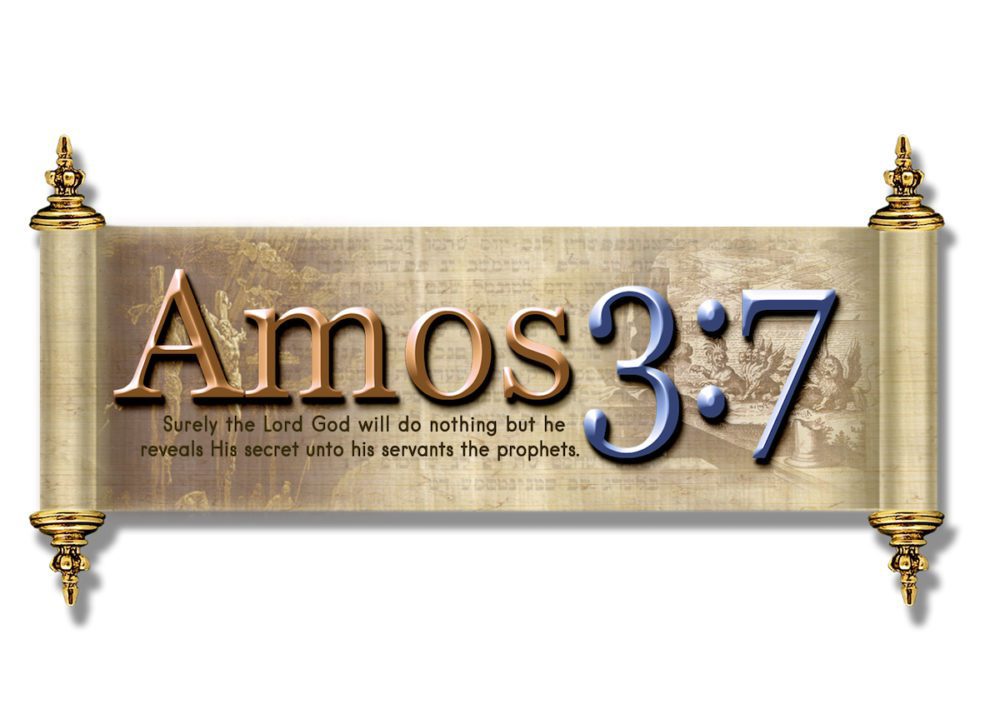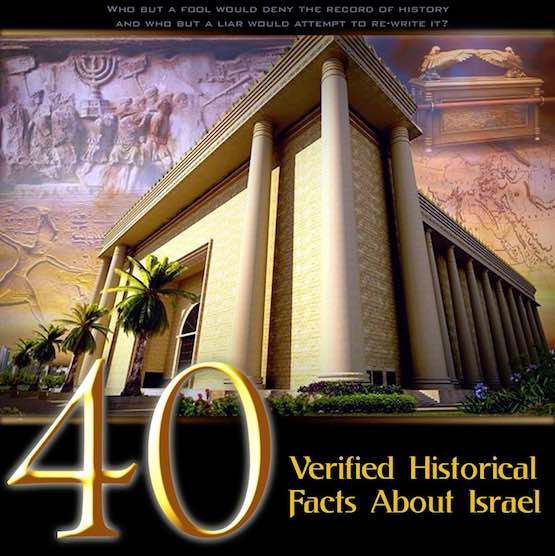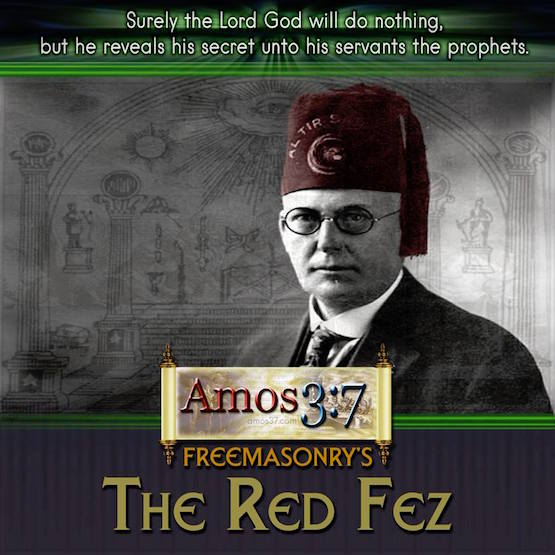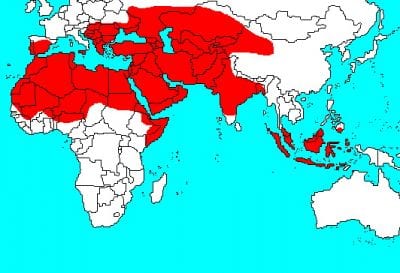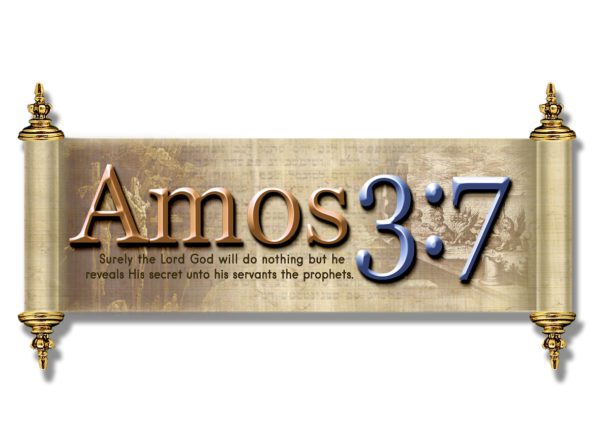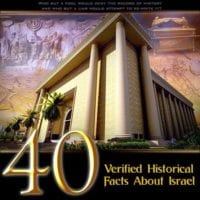 The Jewish people have had an inseparable relationship with the Land of Israel – the Land of the Bible, for the past 4,000 years since the days of Abraham. There have been ebbs and flows in Jewish habitation of the land. However, to be sure, at no period since the days of Joshua have all of the Jewish people been exiled from the Land of Israel. Some Jews have always remained in the Land, in greater or lesser numbers. While their exiles under the Assyrians and Babylonians were relatively short lived, the last greater exile by the Romans lasted almost 1,800 years. Updated and Linked by Keith@Amos37
The Jewish people have had an inseparable relationship with the Land of Israel – the Land of the Bible, for the past 4,000 years since the days of Abraham. There have been ebbs and flows in Jewish habitation of the land. However, to be sure, at no period since the days of Joshua have all of the Jewish people been exiled from the Land of Israel. Some Jews have always remained in the Land, in greater or lesser numbers. While their exiles under the Assyrians and Babylonians were relatively short lived, the last greater exile by the Romans lasted almost 1,800 years. Updated and Linked by Keith@Amos37
Nevertheless, God said He would restore His people Israel to their land in one final and great return and restoration. There are a multitude of biblical prophecies concerning the regathering of the Jewish people from around the world to a barren land that would be restored to its former glory. This began to unfold in the late 1800s. Events leading to the establishment of the modern State of Israel began during the period when the Ottoman (Turkish) Empire controlled the region, then called “Palestine”.
The chronology of past invaders who ruled in the land of Israel reads like a Who’s Who of World Empires. The Land of Israel was a choice fruit that everyone wanted to pluck for their own ends. Those characteristics that made this land desirable enough to be chosen by the Lord as “His Land,” also made it the focus of empires who wanted to rule the world. In some cases, they just wanted to overrule the Jewish people, because they were the people of God and some of these world powers were opposed to the things of God. Israel and the Jewish people are some of those important “things” of God.
In this Israel Teaching Letter, I want to traverse the significant facts of over 4,000 years of Israel’s history so that we have a foundation to validate the Jewish claim to this land. Denying the historical record is like denying your own reflection.
Fact Number 1
According to many scholars, the Patriarchs: Abraham, Isaac and Jacob, were active in Canaan between 2100-1875 BC. The birthright to the covenant established with Abraham in Genesis 12:1-3 was passed on from Abraham to Isaac (not Ishmael or the other sons of Abraham), to Jacob (not Esau), and through Jacob’s twelve sons who became known as the Twelve Tribes of Israel.
The twelve sons of Jacob were Reuben, Simeon, Levi, Judah, Zebulun, Issachar, Dan, Gad, Asher, Napthtali, Joseph and Benjamin. God withdrew Levi from the list of tribes to use the Levites in the transport and care of the tabernacle and its service (Num. 1:47-53). Why Joseph was withdrawn from the list, we are not told, but his two sons, Ephraim and Manasseh (two half tribes), were selected to make up the number of twelve. Some suggest it was an expression of the double portion of inheritance to a firstborn son, showing that Joseph’s dream was, in fact, true.
After Jacob’s son, Joseph, was sold into slavery and eventually became the Prime Minister of Egypt, the rest of the family found refuge there from a regional famine. They remained in Egypt, and the Hebrews ultimately became slaves under a Pharaoh “that knew not Joseph.”
Fact Number 2
As promised, about 400 years after Joseph first came to Egypt, a redeemer was raised up to bring the Children of Israel out of the land of Egypt in a great Exodus. His name was Moses. It was God’s intention for the Children of Israel to move into the Promised Land directly, but they chose to stay in the desert after receiving the report of the twelve spies that the people of the land were powerful and their cities fortified. Despite the fact the Joshua and Caleb brought examples of the produce of the land – grapes, figs and pomegranates – the people chose not to enter. Not violating their freewill, God kept them in the desert for 40 years, so that the second generation was the one to move into and conquer the Promised Land.
Even though the first generation of Hebrews who left Egypt in the Exodus showed a lack of faith in God, choosing not to enter the Promised Land immediately, God was still with them. He provided shelter, food (manna and quail), shoes that would not wear out, and showed Himself in a pillar of cloud by day and a pillar of fire by night. He still loved them even though they disobeyed Him. He protected them so that their children could fulfil His calling to enter into His land.
Fact Number 3
After God brought Joshua and the Israelites into the Promised Land, it took hundreds of years to conquer the land, just as God had said:
“The Lord your God will drive out those nations before you, little by little. You will not be allowed to eliminate them all at once, or the wild animals will multiply around you. But, the Lord your God will deliver them over to you, throwing them into great confusion until they are destroyed. He will give their kings into your hand, and you will wipe out their names from under heaven. No one will be able to stand up against you; you will destroy them. The images of their gods you will destroy by fire” (Dt. 7:22-25a).
The Bible is very specific as to where the Twelve Tribes of Israel were settled in the land, describing their territorial claims in great detail. With a Bible and current map of Israel, you can still trace the borders of these tribal regions. Reuben, Gad and the half-tribe of Manasseh were settled on the east side of the Jordan River (Num. 32:33). The other nine and one-half tribes were settled west of the Jordan as recorded in Joshua 15-19.
Fact Number 4
Saul became Israel’s first king in about 1050 BC. However, only under Kings David and Solomon, Israel second and third kings, did the nation fully consolidate into the Davidic (1010-970 BC) and Solomonic (970-930 BC) empires. Solomon’s empire incorporated all the land from the Sinai desert up to the Euphrates River, but not the totality of what God had promised to Israel. Prophetically, this will come to pass in a day to come.
Fact Number 5
In 1004 BC, Jerusalem became the capital of a United Israel, by God’s choice. It was specially located to be the administrative and spiritual centre of the kingdom, on the border between the tribal area of Judah and Benjamin. It was not located on any major trade route, nor a major waterway or seaport, or near an economic or agricultural resource. Jerusalem’s only main attraction was the Temple of the Lord and His Presence, even in the past. Other empires and religions only wanted to conquer Jerusalem because of its spiritual identity and importance in the Bible.
David conquered the city and bought the threshing floor of Araunah for fifty shekels of silver for the House of the Lord. Eventually Solomon built the Temple (II Chr. 3:1), and to this day, the only recorded deed for this land is in the Bible. However, instead of there being a Jewish Temple to the Lord there today, there are several Moslem mosques on this site and religious Jews and Christians are forbidden to pray on this Temple Mount. Yet, according to the Bible and history, it is a sacred area that does not belong to the Moslems, but to the Jews. It is also the site for the Third Temple that is yet to be built (Eze. 40-44), so one day its status will change.
Fact Number 6
After Solomon’s death in 930 BC, the United Kingdom was divided into a northern kingdom (Israel), with its capital in Samaria, and a southern kingdom (Judah), with its capital in Jerusalem.
The major kings of the northern kingdom (Israel) were: Jeroboam I (928-907 BC), Nadah (907-906), Baasha (906-883), Omri (882-871), Ahab (871-852), Joram (852-842), Jehu (842-814), Jehoahaz (814-800), Jehoash (800-784), Jeroboam II (784-748), Menahem (747-737), Pekahiah (737-735), Pekah (735-733), and Hoshea (733-724). The line ended with the Assyrian Captivity in 722 BC.
The major kings of the southern kingdom (Judah) were: Rehoboam (928-911 BC), Abijah (911-908), Asa (908-867), Jehoshaphat (867-846), Jehoram (846-843), Athaliah (842-836), Joash (836-798), Amaziah (798-769), Uzziah (769-733), Jotham (750-735), Ahaz (733-727), Hezekiah (727-698), Manasseh (698-642), Joshiah (639-609), Jehoiakim (608-598) and Zedekiah (596-586). The line ended with the Babylonian Captivity in 586 BC.
The major prophets of the northern kingdom (Israel) were: Elijah (875-848 BC), Elisha (848-797), Jonah (785-775), Amos (760-750), and Hosea (750-715).
The major prophets of the southern kingdom (Judah) were: Obadiah (855- c.840), Isaiah (740-681), Jeremiah (626-585) and Ezekiel (593-571). After the exile, we find Daniel (605-530), Zechariah (520-480), and Malachi (440-430).
Fact Number 7
In 722 BC, judgment came upon the northern kingdom when Sennacherib, King of Assyria, conquered it, but unsuccessfully laid siege to Jerusalem. King Hezekiah built the underground water tunnel that emptied into the Pool of Siloam so that the people had water inside the city walls. The angel of God killed Sennacherib’s army on the hills around Jerusalem and he went home in shame (II Kgs. 19). In the record of his life, Sennacherib recorded the event just as it is told in the Bible.
In 586 BC, the southern kingdom of Judah eventually fell to Nebuchadnezzer, King of Babylon, who captured and destroyed Jerusalem, dismantling the First Temple of God. The Ark of the Covenant disappeared at this time. Many speculate on where it is, but no one has made such a discovery public. Judah was taken into captivity in Babylon (II Kgs. 25).
Fact Number 8
In 539-537 BC, following a decree by the Persian King Cyrus who had conquered Babylonia, some Jews returned to Israel. An estimated 50,000 embarked on their First Return, led by Zerubbabel, a descendant of the House of David. The first thing the people did was to reestablish the Temple of the Lord, as recorded in the book of Ezra. Less than a century later, in 445 BC, a Second Return was led by Ezra the Scribe and Nehemiah. They undertook a massive reconstruction and fortification of the city walls and the further development of the Temple of the Lord, as recorded in the Book of Nehemiah. The establishment of this Second Temple was ultimately enlarged and beautified by Herod the Great, 500 years later.
The repatriation of the Jews, Ezra’s inspired leadership, the building of the Second Temple, the refortification of Jerusalem’s walls and the establishment of the Knesset HaGedolah (Great Assembly), which was the supreme religious and judicial body of the Jewish people, marked the beginning of the Second Commonwealth (Second Temple Period). Within the confines of the Persian Empire, Judah was a nation cantered in Jerusalem, whose leadership was no longer under a king, but entrusted to the High Priest and the Council of Elders.
Fact Number 9
In 350 BC, the Persians captured Jerusalem. This was closely followed by the Greeks under the leadership of Alexander the Great in 332 BC. After Alexander died, the region was divided up among his three chief generals. In 313 BC, Ptolemy I of Egypt ruled Jerusalem. Then, in 170 BC, the Seleucid king, Antiochus Epiphanes IV, King of Syria, plundered Jerusalem and forced the Jews to stop worshipping the God of Israel, and to worship the pagan gods of the Greeks. During this time, many Jews followed Greek customs and became Hellenized.
When Antiochus Epiphanes IV desecrated the Temple by sacrificing a pig on the altar of God and forced the Jewish people in the towns and villages to do the same, this was too much for some religious Jews. In 167-4 BC the Hasmoneans revolted, led at first by Mattathias of the priestly Hasmonean family, and upon his death by his son Judas, known as the Maccabee (hammer). The terms Hasmoneans or Maccabeans can be used interchangeably.
On the 25th of Kislev, 165 BC, the Hasmoneans captured the Temple, which they purified for proper worship. However, they only had enough sacramental oil for the Temple lampstand for one day. Yet, God allowed it to burn for eight days until enough new oil could be prepared. From this miracle, we get the holiday of Hanukkah that is still celebrated today. Jesus also celebrated this holiday, also known as the Feast of Dedication, “And it was at Jerusalem the Feast of the Dedication, and it was winter” (John 10:22).
The Hasmonean Empire was quite successful and achieved independence from the Seleucids. The Hasmonean rulers became hereditary kings and regained boundaries not far short of Solomon’s kingdom. During the period of the Hasmonean dynasty, which lasted about 80 years (142-63 BC), political consolidation under Jewish rule was attained and Jewish life flourished again in Israel and Jerusalem.
Fact Number 10
In 63 BC, the Romans invaded the region, led by Pompeii. They granted the Hasmonean king, Hyrcanus II, limited authority under the Roman governor of Damascus. The Jews did not accept the Roman rule well, as evidenced by numerous insurrections. The last attempt to restore the former glory of the Hasmonean dynasty was made by Mattathias Antigonus in 40 BC. His defeat and death three years later at the hands of the Romans brought Hasmonean rule to an end, and the land became a vassal state of the Roman Empire.
In 37 BC, Herod, son of an advisor to King Hyrcanus II and married to his daughter, was appointed King of Judea by the Romans. Although he had no authority in foreign policy, he was granted almost unlimited autonomy in the country’s internal affairs and became one of the most powerful monarchs in the eastern part of the Roman Empire. The main regional names for the area can be found in the New Testament, which are: Judea, Samaria, and Galilee west of the Jordan River, and the Decapolis and Perea east of the Jordan River. The name Palestine is not found anywhere in the Bible and is a name given to the land by the Romans 100 years after the death and resurrection of Jesus.
Herod was known as a master builder and built a huge port city in Caesarea (named after Caesar), and fortifications: the Herodian (southeast of Bethlehem), Sabastia in the mountains of Samaria, and Masada on the western shore of the Dead Sea.
Jerusalem, however, was Herod’s crown jewel where his building programs went on for decades as he made this city one of the wonders of the world. In 20 BC, Herod began the expansion and beautification of the Temple, which must have been a site to behold from the Mount of Olives, as the pilgrims came from the Jordan Valley up to Jerusalem.
Fact Number 11
Jesus was born approximately 3 BC and spent his entire life and ministry in the Land of Israel. The religious and political influences of this period greatly affected His ministry and ultimately resulted in His crucifixion in Jerusalem, which was then part of the Roman province of Judea.
Herod was not a very popular king for two main reasons. First, he was a puppet of the Romans who were occupiers and made the people subject to Rome. More importantly, Herod was Idumean (from the line of Esau), making him illegitimate as a true king of Israel because he was from the wrong covenant/family line. This was good for the Romans, because Herod was acceptable enough to be king, but also unacceptable enough that they knew the people would never follow him into a revolt.
In AD 6, Judea was brought under direct Roman administration, because the heirs of Herod who sat on the throne of Judea became progressively ineffective.
Simultaneous with the introduction of direct Roman rule, a Jewish Resistance Movement, called the Zealots, began to organize and rebel against Rome. Eventually, a full-scale revolt against Roman rule took place in AD 66-73.
Fact Number 12
In AD 70, the Roman siege of Jerusalem lasted for 134 days, resulting in the sacking of Jerusalem by Titus and the destruction of the Second Temple of God.
According to the first century historian, Flavius Josephus, an estimated one million Jews perished in the siege of Jerusalem alone, with many killed elsewhere in the country and tens of thousands sold into slavery.
Nearly 1,000 Jewish men, women and children who had survived the fall of Jerusalem occupied and fortified King Herod’s mountaintop palace complex of Masada on the western shore of the Dead Sea. For three years, they held out against repeated Roman attempts to dislodge them. When the Romans finally broke through the fortress, they found that the defenders and their families had chosen to die rather than be enslaved. Ten men were chosen by lot to kill everyone, then one killed the nine and only one killed himself. The ten lots, written on broken pottery shards, were discovered by archaeologists when Masada was excavated in the 1960-70s.
After the fall of Jerusalem, the Sanhedrin (Supreme Jewish Council headed by the High Priest with religious, civil and criminal jurisdiction) was reconvened in Yavneh and later in Tiberias. With the Second Temple, the central focus of Judaism, destroyed, the Sanhedrin needed to interpret how Judaism would be practiced. The priests of the Temple were replaced by community rabbis and, in the absence of a central place of worship, the synagogue became the hub of each community. Judaism had to be reinterpreted so that it could survive without the Temple in Jerusalem. The beginnings of rabbinical Judaism were established here.
Fact Number 13
Meanwhile, Christianity was spreading throughout the world. According to the Book of Acts, Jerusalem was the seat of the first Church Council (Acts 15) and remained the centre of the faith for centuries. Christianity spread from Jerusalem out to the provinces of the Roman Empire, yet encountered opposition, because new religions were forbidden under Roman Law. Christianity was considered a “religio ilicita,” an illegal religion, and Christians were gravely persecuted and even put to death for their faith.
There was a brief period of Jewish sovereignty at the turn of the first century, which was followed by a revolt of Shimon Bar Kochbah from AD 132-135. There was a large-scale slaughter of Jews. Jerusalem was razed and then rebuilt by Hadrian and renamed ” Aelia Capitolina,” after himself (his family name being Aelia). Jews were excluded from Jerusalem. To further blot out the connection between the Jews and the land of Judea, Samaria and Galilee, Hadrian renamed it Syria Palestina, a name that remains in opposition to the correct name, “Israel” to this day.
Fact Number 14
Constantine, the Emperor of Rome, became a ‘Christian’ in AD 306. No longer was Christianity persecuted in the Empire. Rather, it became the religion of the Empire, and Judaism and the Jewish people were persecuted.
In AD 324, the ‘Holy’ Roman army swept into Jerusalem to claim the origins of the faith and established Byzantine rule. In 326, Queen Helena (mother of Byzantine Emperor Constantine) visited Jerusalem and began building major churches including the Holy Sepulchre in Jerusalem and the Church of the Nativity in Bethlehem.
Fact Number 15
In the early 7th century at the dawn of Islam, Jerusalem changed hands several times. In 614, the Byzantine lost Jerusalem to the Persians, and then regained it in 629. However, in 638 Islamic forces swept in, under the Caliph Omar Ben Hatav, capturing Jerusalem and the land of the Bible and placing it under Arab Muslim rule. From 688-91, the Dome of the Rock was built by Abdal-Malik on the Temple Mount. Even though it is the most prominent feature on the Temple Mount, the more holy site to the Moslems is the Al Aksa Mosque, which was a Byzantine Church before being converted into a mosque. Supposedly, Mohammed stopped off on this site on his way to heaven, even though Jerusalem is never mentioned in the Koranic texts.
Life under Islamic rule continued uninterrupted for about 400 years, with caliphs ruling first from Damascus, then from Baghdad and Egypt. In the 11th century, conflict between Moslems and Christians began to increase. In 1009, the Moslem Caliph Hakim ordered the destruction of churches and synagogues.
Fact Number 16
In 1096, the First Crusades from Europe captured Jerusalem. This Crusader rule lasted until 1291. When the Crusaders entered the land, they slaughtered Moslems and Jews in their wake. They even killed many Christians because they “looked” Middle Eastern and were assumed to be Moslems. In Jerusalem, Jews were found praying in their synagogues for God’s mercy when found by the Crusaders. By Crusader accounts, they put wood around the synagogues and burned the Jews alive while they sang the hymn, ” Christ, We Adore Thee.” Those who were not killed were sold into slavery.
In 1099, the First Latin/Christian Kingdom was established by Godfrey of Bouillon. In 1187, the Moslem warrior, Saladin, captured Jerusalem from the Crusaders. In 1192, Richard the Lionhearted tried and failed to reconquer Jerusalem. Yet the Crusaders remained in the land until 1291, when Moslem Mameluks from Egypt put an end to Crusader domination of the Land, as they conquered the entire region.
The Crusaders mainly concentrated on fortifying cities and building castles. They also opened up transportation routes from Europe that allowed for better trade and an onslaught of Christian pilgrimage. Although the Land was under Christian domination, it did not become a Christian country.
Fact Number 17
The Moslem Mameluks conquered the Christian Crusaders and ruled from 1291-1516 and the Land became a forgotten province ruled from Damascus. Akko, Jaffa, and other ports were destroyed for fear of new Crusades, and international commerce was interrupted. The urban centers were virtually in ruins, most of Jerusalem was abandoned, and the small Jewish community living there was poverty-stricken. The period of Mameluk decline was darkened by political and economic upheavals, plagues, locust invasions and devastating earthquakes.
In 1517, Turkish Sultan Selim conquered Jerusalem and the Land of Israel for the Ottoman Empire. Turkish rule lasted until 1917, when World War I resulted in the breakup of this empire into multiple states within the Middle East.
In 1535-8, the Turkish Suleiman the Magnificent rebuilt the ramparts and wall around Jerusalem. In 1541, the Moslems sealed the Golden Gate to prevent Messiah’s entrance (according to Jewish tradition).
The Ottoman Turks divided the land into four districts and attached it administratively to Damascus.
At the beginning of Ottoman rule, it is estimated that 1,000 Jewish families lived in the country, residing mainly in Jerusalem, Nablus, Hebron, Gaza, Safed and the villages of Galilee. The community was comprised of descendants of Jews who had never left the Land, as well as immigrants from North Africa and Europe. Under the Turks, Jews immigrated to the land, with as many as 10,000 settling in Safed.
Fact Number 18
The 19th century saw signs of Western progress with European powers jockeying for position, often through missionary activities. British, American and French scholars launched studies of biblical geography and archaeology, consulates were opened in Jerusalem, steamships began to bring travelers and trade from Europe, postal and telegraphic connections were installed, and the first road was built connecting Jerusalem and Jaffa. The Land’s rebirth, as the crossroads of three continents, was accelerated by the opening of the Suez Canal.
Of all the groups living in Jerusalem, since 1818 the Jewish population has been the religious majority. The first official census in 1844 confirms Jewish religious majority: 7,120 Jews, 5,760 Muslims, and 3,390 Christians.
Up until 1860, everyone in Jerusalem lived inside the walls of the ancient city and the gates were secured at sunset each day. At this time, the population had grown to the point that there was no more room. The first Jewish suburb, Mishkenot Sha’ananim, was built near the Jaffa Gate outside the Old City walls in 1860 by Sir Moses Montefiore. Seven similar neighborhoods were also built outside the walls, e.g., Nahlat Shiva (1869), Mea Shearim (1873-75), and Yemin Moshe (1892), etc. These became the nucleus of the New City of Jerusalem. Some are the quaintest and most interesting neighborhoods of Jerusalem today.By 1880, the Jewish population was the absolute majority in Jerusalem.
Fact Number 19
In the 1880s, we begin to see major fulfillment of Bible prophecy, concerning the Jewish people and the Land of Israel.
The modern State of Israel is directly connected to biblical Israel, as attested to by its history and the manner in which its modern rebirth has so closely coincided with Bible prophecy. Just as God arranged for Joshua to bring the Children of Israel into the Promised Land 3,500 years ago, in our day God arranged for the Jewish people to come back to their ancestral homeland.
The Turkish Ottoman Empire ruled the entire Middle East region from 1516 – 1917.
During these 400 years of harsh Turkish rule, the land of Palestine (Israel) was sparsely populated, mostly by nomadic peoples. By the end of the 18th century, much of the land was owned by absentee landlords and leased to impoverished tenant farmers. It was poorly cultivated and a widely-neglected expanse of eroded hills, sandy deserts, and malarial marshes encroached on what was left of agricultural land. Its ancient irrigation systems, terraces, towns and villages had crumbled. Taxation was crippling, with its forests being taxed. When the people could not pay the tax, the trees were cut down to fuel the steam engines carrying goods between Istanbul, Beirut, Damascus and Cairo. The great forests of the Galilee and the Carmel mountain range were denuded of trees; swamp and desert encroached on agricultural land. “Palestine” was truly a poor, neglected, no-man’s land with no important cities.
Mark Twain, who visited “Palestine” in 1867, described it as a “…desolate country whose soil is rich enough, but is given over wholly to weeds – a silent mournful expanse … We never saw a human being on the whole route … There was hardly a tree or a shrub anywhere. Even the olive and the cactus, those fast friends of a worthless soil, had almost deserted the country.”
The report of the Palestine Royal Commission [British] quotes an account of the condition of the Coastal Plain along the Mediterranean Sea in 1913: “The road leading from Gaza to the north was only a summer track suitable for transport by camels and carts… no orange groves, orchards or vineyards were to be seen until one reached Yavne village… houses were all of mud. Schools did not exist… The western part, towards the sea was almost a desert… The villages in this area were few and thinly populated… many villages were deserted by their inhabitants.”
The French author, Voltaire, described “Palestine” as “a hopeless, dreary place.” In short, under the Turks, the land suffered both from neglect and a low population.
Fact Number 20
Today, the Land of Israel is rejoicing with life, which has been restored to the country since the Jewish people began their return in the late 1800s. This process has not been without its difficulties. Remember, however, when we read the book of Joshua, we see that even though God said He was bringing the Israelites into their Promised Land, which He gave them, the movement into the land was not without its great problems. The enemies of the Bible and God’s plans are always in opposition to it.
In the 1880s, while still under Turkish rule, it is as though a giant electro-magnet were turned on in the Land of Israel. Jews began to immigrate to what was then called Palestine. They came from Yemen in the south and Russia in the north, Morocco in the west, and Iraq in the east. This move into Israel was the beginning of the fulfillment of the prophetic return to Zion, which has been taking place over the past 120 years in a series of Aliyot, or large moves of Jewish populations into the land of Israel. (Aliyah is a Hebrew term for “going up” or immigration.) Despite a myriad of difficulties, the Jewish people were not prevented from coming home to Zion by the millions.
The First Aliyah (immigration) started in the 1880s when new Jewish communities began to spring up, including Petah Tikva, Rosh Pinna, Rishon le Zion, Gedera, and Zichron Ya’acov. Jews purchased land at high prices, 73% of it from absentee Arab landlords who lived in Cairo, Damascus and Beirut.
About 80% of the Arabs living in Palestine came from different parts of the Ottoman Empire to work for these landlords and were debt-ridden peasants, semi-nomads and Bedouins. Most of the land purchased had not been cultivated previously because it was swampy, rocky, sandy, or for some other reason, regarded as uncultivable.
According to the Peel Commission (British, 1937): “The Arab charge that the Jews have obtained too large a proportion of good land cannot be maintained. Much of the land now carrying orange groves was sand dunes or swamp and uncultivated when it was purchased.”
Moreover, the price the Jews paid for this barren land was exorbitant. In 1944, Jews paid between $1,000 and $1,100 per acre in Palestine, mostly for arid or semi-arid land; in the same year, rich black soil in Iowa was selling for about $110 per acre (U.S. Dept. of Agriculture).
Fact Number 21
In 1897, Jewish leaders, moved by Theodore Herzl, formally organized the Zionist movement at the First Zionist Congress in Basle, Switzerland. They called for the restoration of the Jewish National Home in Palestine where Jews could have sanctuary, self-determination and the renascence of their ancient civilization and culture.
In 1898, Theodore Herzl met Kaiser Wilhelm just outside Jerusalem’s Jaffa Gate.
William Hechler, a Bible-believing Protestant and Christian Zionist, had a profound influence on Herzl, as he supported and motivated him to continue with his goal of establishing a Jewish State in Palestine. Hechler was motivated by his reading of the Bible prophets and his belief that the God of Israel was able to fulfill these prophecies for His people, Israel, in their ancient homeland.
At the First Zionist Congress in 1897, Herzl predicted that in 50 years, the State of Israel would be a reality. Exactly fifty years later, in 1947, the United Nations voted for Israel to be a state (Nov. 29, 1947), and on May 14, 1948, the new flag of Israel was raised.
Meanwhile, Jews began to come in waves from different parts of the world. What was called, “The Second Aliyah,” or the second wave of Jewish immigration, took place in the early 1900s. They came from Russia as a result of the Pogroms against the Jewish citizens there. The movie, “Fiddler on the Roof,” depicts Jewish life in Russia at this time, when many were forced to leave. Some Jews came to Palestine.
As the Jews immigrated and began to develop the region, Arabs from many parts of the impoverished, decaying Ottoman Empire of the Middle East rushed into Palestine to get jobs. Many of today’s “Palestinians” are descendants of these newcomers.
Fact Number 22
The Middle East became enveloped in World War I, which began in 1914. In 1916, even before Britain and France had conquered the Ottoman Empire, they set up an Anglo-French commission to submit an agreed plan for the postwar partition of the Ottoman Empire. The British representative was Sir Mark Sykes and the French representative was Charles Francois Georges-Picot. The agreement became known as the Tripartite (Sykes-Picot) Agreement of 1916, which effectively drew the borders of the new states of the Middle East. Their interests were more in favor of the strategic interests of Britain and France, not necessarily the people who would live in this region. Consequently, Kurdistan was apportioned to Turkey, Syria, Iraq and Iran and to this day, the Kurds are disenfranchised.
Most of the modern Arab states of the Middle East owe their borders to the Sykes-Picot Agreement, as does Israel.
While many believe that Israel is a new state to the region, having only acquired its sovereignty in 1948, it needs to be remembered that the other Middle East states also acquired their independence in this century, e.g., Saudi Arabia (1913), Lebanon (1920), Iraq (1932), Syria (1941), Jordan (1946), and Kuwait (1961).
Therefore, none can boast historical claims to this or that border, other than the very ancient and historically verified claims, including those of the Jews in the Land of Israel with the Bible as their deed.
After World War I, the Turks were defeated and the British began to rule what was known as the British Mandate of Palestine, which lasted from 1917-1948.
This was the first time Christians had ruled Jerusalem since the days of the Crusaders. While there were three Jewish Legions fighting with the British forces, the British were considered a Christian nation by the Moslems of the Middle East. The General that led the forces was General Edmund Allenby. As part of his campaign, leaflets were dropped from a plane on the inhabitants of Jerusalem. These leaflets were printed in Arabic telling them to surrender, and they were signed by General Allenby. In Arabic, his name could be misread as “Allah Nebi” which means, a Prophet of Allah, which added great fear into the hearts of those who thought to defy this command.
Allenby was a devout Christian and it is said he always kept the Bible at his bedside. Out of respect for the city, he dismounted his horse as he approached Jaffa Gate, entered Jerusalem on foot, and declared, “We have returned to you!” This was on December 11, 1917, and British rule lasted until 1948, when Israel became a sovereign nation.
At the beginning of British rule, there was an effort to reinforce the national aspirations of both the Arabs and Jews of the region. As the Turkish Empire was being dissolved and redivided among various ethnic groups, the horizon looked bright for the creation of a Jewish state in the Middle East along with numerous Arab Moslem states.
Fact Number 23
On October 31, 1917, the British War Cabinet accepted the Balfour Declaration, which was issued on November 2, 1917, as government policy. It stated:
“His Majesty’s Government views with favour the establishment in Palestine of a national home for the Jewish people, and will use their best endeavours to facilitate the achievement of this object, it being clearly understood that nothing shall be done which may prejudice the civil and religious rights of existing non-Jewish communities in Palestine or the rights and political status enjoyed by Jews in any other country.”
The Balfour Declaration was the result of “circumstances” that brought the early Zionist leader, Dr. Chaim Weizmann, a British scientist, into contact with the ex-prime minister of Britain, Arthur James Balfour. His scientific gifts enabled him to render important services to the Admiralty and the Ministry of Munitions. These gifts, including his invention of TNT, which helped win the war, brought him to the attention of Lloyd George, who became Minister of Munitions in the spring of 1915. All the while, Weizmann was spreading his message, to all those who would give him an ear, of the need for a homeland in Palestine for the Jews. These included Balfour and Lloyd George.
In 1916, just before Britain conquered Palestine, there was a change of government in Britain, and Balfour became the Foreign Secretary and Lloyd George, the Prime Minister. Weizmann helped to draft the Balfour Declaration and it was accepted by the War Cabinet and became government policy.
Was this “circumstance” or was it God moving the hand of history to His prophetic end?
The Balfour Declaration won the approval of the United States and other Western powers. At first, there was hope that the Arabs would also accept it, as both the Arabs and the Jews were just breaking free from the yoke of the Ottoman Empire.
Fact Number 24
Emir Faisal, son of the acknowledged leader of the Arabs, Sherif Hussein, met with Dr. Chaim Weizmann and other Zionist leaders during the 1919 Paris Peace Conference. They signed an agreement by which the Arabs stated that “mindful of the racial kinship and racial bonds existing between the Arabs and the Jewish people,” they declared that “the surest means of working out the consummation of their [Jewish] national aspiration is through the closest possible collaboration of the development of the Arab state AND Palestine.” (In 1919, Palestine was considered that portion of the Middle East designated for the Jewish people.)
The agreement between Faisal and Weizmann looked to the fulfillment of the Balfour Declaration and also called for “all necessary measures… to encourage and stimulate immigration of Jews into Palestine on a large scale, and as quickly as possible to settle Jewish immigrants upon the land through closer settlement and extensive cultivation of the soil.”
On March 3rd, one day after Weizmann presented the Zionist case to the Peace Conference, Faisal wrote to Felix Frankfurter, a U.S. Supreme Court Justice and Zionist leader, declaring:“The Arabs, especially the educated among us, look with deepest sympathy on the Zionist movement … We will wish the Jews a hearty welcome home … We are working together for a reformed and revised Near East and our two movements complete one another. The Jewish movement is nationalist and not imperialist. Our movement is nationalist and not imperialist. And there is room in Syria for us both. (Under Turkish rule, Syria included part of Palestine.) Indeed, I think that neither can be a real success without the other.”
Faisal had conditioned his acceptance on the fulfillment of British wartime promises to the Arabs, who had hoped for independence in a vast part of the Ottoman Empire.
These hopes were temporarily dashed when the French took over the mandate for Syria, ejecting Faisal from Damascus, where he had been proclaimed King of Syria. As consolation, the British named Faisal King of Iraq. And in a further effort to please the Arabs, British Colonial Secretary, Winston Churchill, cut away 80% of the Jewish National Home in Palestine, some 35,000 sq. miles (90,565 sq. km.) and created a brand new Arab entity, called Transjordan. Churchill installed Faisal’s brother, Abdullah, as Emir. (Abdullah is the great-grandfather of the present-day King Abdullah II of Jordan.) Britain administered Transjordan until 1946, when independence was granted, and the name of the area became the Hashemite Kingdom of Jordan.
Fact Number 25
This apportionment – the first partition of Palestine and of the promised Jewish National Home – was a blow to the Zionists. The Jewish people reluctantly accepted the partition because Britain simultaneously took over the League of Nations Mandate for Palestine in 1922, and they really had no one to which they could appeal.
It should be emphasized that Arab hopes for a vast empire have since been realized.
Today, the Arab League includes 21 separate Arab states spanning an area of more than 5,000,000 square miles (12.9 million sq. km.)
However, there is only one Jewish state consisting of 8,000 square miles (20,715 sq. km.). It is called Israel.
While the Arabs showed early signs of acceptance of a Jewish state in Palestine in 1919, later it would be seen that once the Arabs had a taste of independent power, they quickly lost interest in encouraging Jewish immigration and a Jewish state.
Nevertheless, the Third Aliyah (Jewish immigration movement) began in 1919, motivated by the Balfour Declaration and an open window of opportunity to bring oppressed Jews from eastern Europe and those fleeing communism which was taking control of Russia and surrounding nations. Over 50,000 Jews immigrated at this time. However, during the 1920s, the Arabs had a change of heart and attacks on the Jews of “Palenstine” began in earnest. The fight was on from the Arab side to negate any hope of a Jewish state.
Fact Number 26
As time went on, the British feared their relations with the Arabs would suffer and sought to protect British oil interests in the Middle East. As World War II loomed on the horizon and oil became a paramount concern, British appeasement to the Arab cause against the Jews of Palestine was obvious. They greatly limited Jewish immigration in the British Mandate.
From 1936-1939, there was an Arab uprising in which 10,000 people were killed. The British showed leniency in the beginning, which resulted in a disaster – 1,000 British were killed, 500 Jews, and 8,500 Arabs (most of the Arabs were killed by other Arabs vying for control). In the end, the British had to use the iron-fist policy to stop the uprising. This event put greater fear into the British, who put further limits on Jewish immigration. The climax was the British White Paper in 1939, which ordered that future Jewish immigration be limited to 10,000 per year for five years and to an additional 25,000 refugees from Nazism – 75,000 in all. Hardly much help while Hitler was killing 6,000,000 Jews during this same period.
At the end of a ten year period, the White Paper called for an independent state in the region – an Arab state!
During WWII, Haj Amin al-Husseini, the Moslem Mufti of Jerusalem (uncle of today’s Palestinian Authority Minister of Jerusalem Affairs, Faisal Husseini), met with Adolph Hitler to organize the extermination of the Jewish populations of the Middle East. Yasser Arafat was also related to this family by his mother.
Fact Number 27
As World War II came to an end, revealing the extent of the catastrophe that had befallen the Jewish people in Europe, there were demands everywhere for swift action to rehabilitate and resettle those who had survived the Holocaust through the establishment of a Jewish state. The British had also tired of their role as supervisors of the British Mandate, which had been maintained since World War I. In Palestine, they were looking for a way out, as well as a way to appease both the Arabs and the Jews of this region.
The Holocaust, which claimed the lives of 6,000,000 Jewish men, women and children, one-third of world Jewry, had a severe impact on the Jewish people which is still prevalent today. However, according to Ezekiel 37, the Valley of Dry Bones, representing the “whole house of Israel,” would rise up out of their graves, come into their land of Israel and become an “exceeding great army.” This occurred in 1948 as a fulfillment of prophecy. God made it happen.
Prior to the founding of the State of Israel, the British tried, but failed, to work out an agreement acceptable to both Arabs and Jews on the issue of Palestine, so they turned the problem over to the UN early in 1947.
The UN sent an 11-nation Special Commission on Palestine (UNSCOP) to the region to investigate. UNSCOP found two people groups, Arabs and Jews, both claiming all the country. To satisfy the national aspirations of both peoples, UNSCOP proposed termination of the British Mandate and a partition of the area into an Arab state and a Jewish state based on population concentrations. Jerusalem would be an international zone.
The Jewish state was already in de facto existence in all areas. So, eager for independence, the Jews of Palestine were ready to accept a compromise – partition. The Arabs boycotted the UNSCOP plan. World opinion strongly favored the UN resolution, and it was adopted by a vote of 33-13, with 10 abstentions, on Nov. 29, 1947.
Throughout the 1947 UN debate, the Palestine Arab Higher Commission threatened war, while Jewish Agency spokesmen appealed for peace. Jamal Husseini, spokesman for the Arab committee, told the UN on Nov. 24, 1947: “The partition line proposed shall be nothing but a line of fire and blood.”
Five days later, the UN voted for the partition and the Arabs began their war to prevent implementation of the UN resolution. Roads were mined, Jewish settlements isolated, and Jewish convoys were ambushed. By the end of that week, 105 Jews had been killed. Later, apartments in Jerusalem were blown up and more than 50 men, women and children were killed. Thirty-five Hebrew University students were massacred on the road near Jerusalem. The Jewish Agency was bombed and took heavy casualties. A convoy was set afire on the road to Hadassah Hospital on Mt. Scopus and 77 Jewish doctors, nurses and scientists died.
Fact Number 28
On May 14, 1948, the State of Israel was declared to be independent and her Declaration of Independence was signed. Among its many clauses, it states: “Eretz Israel (the Land of Israel) was the birthplace of the Jewish people. Here, their spiritual, religious and political identity was shaped. Here they first attained to statehood, created cultural values of national and universal significance and gave to the world the eternal Book of Books….
Jews strove in every successive generation to re-establish themselves in their ancient homeland… they made deserts bloom, revived the Hebrew language, built villages and towns, and created a thriving community, controlling its own economy and culture, loving peace but knowing how to defend itself….
The State of Israel… will foster the development of the country for the benefit of all its inhabitants; it will be based on freedom, justice and peace as envisaged by the prophets of Israel; it will ensure complete equality of social and political rights to all its inhabitants irrespective of religion, race or sex; it will guarantee freedom of religion, conscience, language, education and culture; it will safeguard the Holy Places for all religions; and it will be faithful to the principles of the Charter of the United Nations.
We extend our hand to all neighboring states and their peoples in an offer of peace and good neighborliness, and appeal to them to establish bonds of cooperation and mutual help with the sovereign Jewish people settled in its own land.”
Fact Number 29
The flag of the State of Israel is based on the design of the Jewish prayer shawl (the tallit), represented in the two blue stripes on a field of white. The blue represents the Holy Spirit of God and the white represents heaven.
In the center, there is the Magen David, the Star of David, a symbol about which books have been written. One of the most meaningful interpretations of the Star of David comes from the noted Jewish scholar, Franz Rosensweig. He sees the Star of David as two triangles superimposed upon one another. One represents the nature of God, as Creator, Redeemer, and Teacher. The other triangle represents the relationships between God, man and others. Both of these interpretations are also consistent with a Christian understanding of the nature of God and man.
What a meaningful flag to have flying over a nation that is the fulfillment of Bible prophecy and the continuation of a covenant established by God with the Jewish people 4,000 years ago. This is a testimony to God’s faithfulness to His people, His land, and His Word.
Fact Number 30
The Arabs rejected the UN partition plan of 1947 and didn’t accept their portion of land. Instead, five Arab armies (Egypt, Syria, Transjordan, Lebanon and Iraq) immediately invaded Israel expecting to sweep the Israelis into the sea.
On May 15, 1948, Azzam Pasha, Secretary General of the Arab League, said in Cairo: “This will be a war of extermination and a momentous massacre which will be spoken of like the Mongolian massacres and the Crusades.”
Fortunately, his words were not prophetic and Israel not only retained that which was given to her by the UN, but a bit more. Those areas designated for the Arab state in Palestine were occupied by other Arab countries: the West Bank (of the Jordan River) by Jordan, and the Gaza Strip by Egypt.
After the establishment of the State of Israel, Jewish refugees of WWII and others from Moslem countries of the Middle East began to pour in. From 1948-1972, over 1,400,000 immigrants came into Israel. All had to be settled, trained, given Hebrew language classes, and many needed health care. All of this cost fell on the shoulders of the Israelis and the Jewish community worldwide.
For the “Palestinian” Arabs of Western Palestine, their rejection of the 1947 Partition Plan and choosing war caused them to miss the first of many opportunities to obtain a national home – missed by their insistence on a policy of “all or nothing.”
The well-known Israeli diplomat, Abba Eban, often declared that “the Palestinians never miss an opportunity to miss an opportunity.”
Arabs of the region also became refugees, when they were encouraged to leave the area by the Arab leadership who intended to “push the Jews into the sea.” However, even greatly underarmed and outnumbered, the Jews were not pushed into the sea and actually added land to their original allocation.
Refugees were created on both sides. However, an exchange of populations had actually taken place. By coincidence, the total number of Arabs who reportedly left Israel equaled the number of Jews who were forced out of the Arab countries. There was also a more than even tradeoff of property between the Jews of the Middle East and the Arabs. The Jews who fled Arab countries where they had lived for 2,500 years, left assets behind far greater than those the Arabs left in Israel. Jewish property that the Arabs confiscated in Iraq, Syria, Libya and Egypt more than offset Arab claims of compensation from Israel.
After the war in the negotiations for an Armistice Agreement in 1949, the Arabs, having lost, insisted that Israel then accept the 1947 partition lines as borders before they would negotiate. Actually, what they were demanding after defeat, was what they could have had before their invasion without firing a shot! The purpose of this declaration by the Arabs was to appear as the defenders of the UN and its resolutions, and to cast Israel as its violator. The opposite was true.
This model created a novel concept, which the Arabs still use to this day: the doctrine of the limited liability war. Under this theory, an aggressor may reject a compromise settlement and may gamble on war to win everything in the comfortable knowledge that, even if he fails, he may insist on reinstating the original compromise and claim rights under it. This has been the pattern in each war of 1948, 1956, 1967, 1973, 1982 and today.
Fact Number 31
Currently, the “Palestinians” define “Palestine” as the region west of the Jordan River, that land comprised of Israel, the West Bank and Gaza. However, according to the PLO Covenant, Palestine was defined as all of the land of Israel and Jordan.
The Arabs claim that Israel has usurped “all of Palestine,” leaving the Palestinian people with nothing. This is simply not the case. Transjordan’s independence, becoming Jordan in 1946, did force an artificial redefinition of “Palestine” to include only that area west of the Jordan River, thus restricting it to 20% of the original Palestine. What the 1947 UN partition did was to further partition the remaining 20% portion into yet another Arab state and a Jewish state. This, however, did not change the fact that Jordan is still part of historical Palestine, with over 70% of its population being Palestinian Arab. (Jordan’s King Abdullah II is Saudi Arabian (father) and British (mother), his great-grandfather having been given this territory by the British after WWI of 80% of Palestine and called the Emir of Jordan under British protection.)
With Jordan ignoring the UN partition and annexing the West Bank in 1949 (also known as Judea and Samaria), Palestinian Arabs under the Jordanian umbrella controlled 82.5% of the Palestine Mandate originally given to the Jews in 1917, while the Jewish State held a bare 17.5%.
Even today, Jordan is still a Palestinian Arab state in territory and by population, on 80% of the original Palestine of the British Mandate. A portion of the land apportioned by God to the tribes of Reuben, Gad, and Manasseh is also in Jordan, east of the Jordan River.
Despite what the Palestinians say, Israel did not usurp all of Palestine, nor are the Arabs left without a Palestinian state. All of Jordan is Palestine too. The current Peace Process, from Oslo to the Wye River agreements, is seeking to find a nation for the Palestinians. However, only Israel is expected to give anything into this new state under the auspices of the Palestinians.
Jordan is giving nothing to the Palestinians. In fact, in Israel’s peace treaty with Jordan, that country took land from Israel. And the Syrians are trying to claim the Golan Heights, which is home to 18,000 Israelis. This small region of 400 sq. miles (1035 sq. km.) also provides 1/3 of Israel’s water supply, and production from its bountiful agriculture and innovative light industry.
The use of the term “Palestine” and “Palestinian,” in association with the Arab population of the region, is a late phenomenon. It developed in the 1970s to give identity to a people who were a collection of Arab immigrants who came to the region in the past 100 years to find work, once the Jews started to arrive and improve the economy.
The noted Arab leader, Auni Bey Abdul-Hadi, told the Peel Commission (1936): “There is no such country [as Palestine]! Palestine is a term the Zionists invented! There is no Palestine in the Bible. Palestine is alien to us; it is the Zionists who introduced it.”
The Jerusalem Post newspaper, founded in 1932, was called the Palestine Post and the Jews of the region were called Palestinians.
In 1946, Princeton professor, Philip Hitti, a distinguished Arab historian testifying before the Anglo-American Committee of Inquiry, stated, “There is no such thing as Palestine in (Arab) history, absolutely not.” He also opposed using the word Palestine on maps, because it was “associated in the mind of the average American, and perhaps the Englishman too, with the Jews.”
The application of the term “Palestinian” to the Arab inhabitants of Palestine to the exclusion of Jews began to evolve in the early 1960s as the Arabs were trying to create a unified identity. However, neither the 1967 UN Security Council Resolution 242, nor the 1973 Resolution 338, mentioned Palestinians at all. It was only in the mid-seventies that the term first started being exploited by the PLO.
Fact Number 32
The Palestine Liberation Organization was founded in May 1964 by the Arab League, having been promoted by Egyptian President Gamal Abdul Nasser. He saw it as a means to advance Egypt’s goals of uniting the Arab world under Egyptian rule, by rallying the Arab states under the banner of destroying Israel. Since 1969 and until his death, Yasser Arafat, the co-founder of the Fatah faction, headed up the PLO.
The PLO Covenant called for the destruction of Israel as well as Jordan, taking all of British Mandate Palestine as a Palestinian State. The Palestinian Authority has administered land and people in the West Bank and Gaza since they were turned over by Israel as part of the Peace Process.
Though the PLO/PA claims that it recognizes Israel’s right to exist and wants to found a state only in Gaza and the West Bank, its official stationery betrays its true goals. The stationery, bearing its official emblem, shows all the land west of the Jordan River including all of Israel. These aims were part of the original charter and the organization’s infamous Phased Program to gain the territory piece by piece until a pan-Arab war could be sparked for the final takeover of all of Israel.
Remember that the PLO was founded before the 1967 Six Day War when Israel won the West Bank and Gaza from Jordanian and Egyptian sovereignty. Therefore, the claims to want only this small portion of their greater vision of all of Israel and Jordan rings hollow. The Arabs had this land before 1967 and still the organization was founded with its true aims of conquering all of Israel for Islam and the Arab world.
A final note on Palestine: Palestine was never a sovereign state (Arab or Jewish) that was somehow eclipsed in war, and thus needs to be reinstated back into the family of nations. What the Palestinian Arabs are asking for would be the creation of a completely new national entity that has never before existed. Palestine (Filastin) was a regional name imposed on the area by the Roman Emperor, Hadrian, to quell the Second Jewish Revolt by eliminating Jewish identification with their land in AD 135. There is no language known as Palestinian. There is no distinct Palestinian culture. There has never been a land known as Palestine governed by Palestinians. Palestinians are Arabs, indistinguishable from Jordanians, Syrians, Lebanese, Iraqis, etc.
Fact Number 33
Before the 1967 Six Day War, Israel was constantly bombarded by artillery fire from Syria on the Golan Heights, and from terrorist raids from Syria, Egypt and Jordan. There were massive military build-ups by the neighboring Arab states, especially Egypt. Egypt moved massive numbers of troops and equipment to the Israel-Egypt border in the Sinai, and ordered out the UN Peacekeeping Forces deployed there since the 1956 war with Egypt over the blockade of the Suez Canal. Egypt reimposed the blockade of the Straits of Tiran in the Red Sea, effectively blocking Israeli shipping trade from the east via Eilat, and made a military alliance with Jordan.
At this point, Israel invoked its inherent right of self-defense and launched a pre-emptive strike on Egypt, destroying her air force before it left the ground. There were counter-attacks from Egypt, Jordan and Syria.
At the end of the Six Day War, the previous ceasefire lines were replaced by new ones, with the West Bank (Judea and Samaria), Gaza, the Sinai peninsula, and the Golan Heights under Israeli control.
Fact Number 34
In 1973 on Yom Kippur (October 6), the Syrians and Egyptians coordinated a surprise attack against Israel. Yom Kippur is the holiest day on the Jewish calendar. It is a 25-hour period of total fasting from food and water, while praying at the synagogue to ask God to forgive one’s sins. On this day, there is no work, no vehicles are on the roads, there is no television or radio, and no equipment operates.
The Egyptians crossed the Suez Canal, while the Syrian troops penetrated the Golan Heights. This lightning attack could have been fatal to Israel. However, God truly intervened. On the Golan Heights, Avigdor Kalahani, the commander of the tank corps, and one other tank managed to hold off the Syrian army until reinforcements could help.
During the next three weeks, the Israel Defense Forces turned the tide of battle and repulsed the attackers, crossing the Suez Canal into Egypt and advancing to within 20 miles (32 km) of the Syrian capital, Damascus. On October 22, the war was over.
In November, 1977, the cycle of constant Arab rejections of Israel’s appeals for peace was broken with the visit of Egypt’s President Anwar Sadat to Jerusalem. An accord was negotiated at Camp David in the USA in September 1978, and a formal peace treaty was signed on the lawn of the White House on March 26, 1979. This made Egypt the first Arab country to accept Israel’s hand in peace extended since 1948.
Fact Number 35
In 1980, a special law was enacted by the Knesset, the Israeli parliament, re-affirming that united Jerusalem is the capital of Israel. Jerusalem has been the capital of no other nation or people in history except the Jewish people. Crown Prince Fahd of Saudi Arabia declared a jihad (a holy war) “to protect the Holy City against Zionist aggression.”
In reaction to this declaration, foreign embassies in the city, including the US Embassy, moved to Tel Aviv. However, in 1990 the US Congress affirmed the need to move the US Embassy from Tel Aviv to Jerusalem, which was ignored by successive US presidents. So, on November 8, 1995, the US Congress recognized united Jerusalem as the capital of Israel in the Jerusalem Embassy Act (public law 104-45), and demanded that the US Embassy be moved from Tel Aviv to Jerusalem. The US Senate unanimously voted for this move; however, Bill Clinton had stopped the US embassy move from occurring. Once the US embassy moves, however, most other countries will follow suit.
Currently, in America, US citizens born in Jerusalem have no country ascribed to their place of birth. It only says, “Jerusalem” on their birth certificates, not “Jerusalem, Israel.” The State Department needs to change their policy on this issue to comply with Congress. Both US presidential candidates are now calling for a move of the Embassy building to Jerusalem.
Furthermore, a number of Islamic countries won’t even acknowledge Israel’s existence which poses considerable problems for travellers as well as citizens.
Fact Number 36
For over a decade after the Palestinian Liberation Organization (PLO) had been forced out of Jordan by King Hussein in 1970, Israel underwent repeated shelling and terror attacks from PLO bases in Lebanon. The PLO had all but taken over parts of Lebanon, and their actions killed and wounded thousands of Israeli civilians who never knew when another attack was coming.
In June 1982, Israel launched the “Operation Peace for Galilee” campaign to rout the PLO out of Lebanon and bring peace and safety to her citizens.
In the first days of the war, approximately 100 Israeli US-made jets faced off over Lebanon’s Beka’a Valley with an equal number of Syrian, Russian-made MiGs. Israel also faced Syrian ground-to-air SAM missiles, which had taken a heavy toll on Israeli planes in 1973. At the end of one day, the Israel Air Force shot down 90 of the Syrian MiGs, while not one Israeli jet was lost. An Israeli government minister commented at the time that this had to be a miracle of God in the face of such odds. “Surely,” he said, “Israel should have lost one plane due to mechanical or human failure.”
The operation achieved its objective within a few weeks, but a weak Lebanese central government kept Israeli troops there until 1985.
In December 1987, a Palestinian uprising called the Intifada erupted and swept throughout the Palestinian communities of the West Bank and Gaza. What had been a relatively benign relationship since 1967 between Israel and the Palestinians in the territories, became a near war. Death and injuries on both sides were high, with great distress filling the hearts of Israelis and Palestinians alike. The Intifada continued for six years, until the current Peace Process began with the Oslo Accords in 1993.
Fact Number 37
In 1989, the Iron Curtain began to fall and Jews began to be liberated from the lands of the north – the provinces of the former Soviet Union where they had been prevented from emigrating to Israel for decades. Since that time, over one million new immigrants have arrived in Israel, including nearly 20,000 Ethiopian Jews from the lands of the south. Together, they fulfill Isaiah 43:5,6.
Meanwhile, in 1991, the Gulf War, which was initiated to restore sovereignty to Kuwait after it was invaded by Iraq, also affected Israel. While Israel was completely out of this war, 39 Scud missiles were fired upon Israel by Saddam Hussein’s forces. He had hoped to draw Israel into the war because of his great hatred of her, but also to split up the Allied coalition that not only had American and European forces, but participants from numerous Moslem Arab countries who have no ties with Israel.
During these dark days and weeks, fearing chemical and biological weapons, Israel prayed Psalm 91: “He who dwells in the shelter of the Most High will rest in the shadow of the Almighty. I will say of the Lord, ‘He is my refuge and my fortress, my God, in whom I trust.’ … He will cover you with His feathers, and under His wings you will find refuge; His faithfulness will be your shield and rampart. You will not fear the terror of night, nor the arrow that flies by day, nor the pestilence that stalks in the darkness, nor the plague that destroys at midday” (Ps. 91:1-2, 4-6).
No chemical or biological weapons were used against Israel. Eleven thousand apartments were destroyed, but only one person died as a direct result of the destruction.
Truly, Israel was protected under the wings of the Lord, in whose shadow she dwells.
Fact Number 38
In 1992, the late Prime Minister Yitzhak Rabin began negotiations with the Palestine Liberation Organization (the PLO) in an effort to make peace for Israel with the Palestinians and other Arab nations. Only Egypt had signed a peace treaty with Israel in March 1979. Rabin and Arafat concluded an initial agreement in 1993, called the Oslo Accords, which was the first of many accords in the quest for peace in the region. To date, Israel has turned over all major centers in the West Bank (Judea and Samaria) and Gaza, while the Palestinians have done little to fulfill their side of the agreements.
In a violation of the Oslo Accords, the PLO has declared over and over again their intentions to unilaterally declare a sovereign Palestinian State with Jerusalem as its capital. Arafat claimed that he would raise the Palestinian flag on the walls of the Old City of Jerusalem and on the tops of the mosques and churches. In January 2000, Arafat declared, “This year is the year for declaring an independent Palestinian State…It is a fundamental thing that this year is the year of the State.” Israel has already made united Jerusalem its undivided capital and will not compromise on this. Therefore, if the PLO persists in pursuing his declared plan, then a conflict and even war is inevitable.
In 1994, Israel signed a peace treaty with King Hussein of Jordan. This has proved to be the warmest of the treaties, thus far. Considerable trade, tourism and other bilateral initiatives have prospered both countries.
Today, “off and on” negotiations continue between Israel and Syria to hopefully secure a real peace with Syria and with Lebanon which is controlled by Syria. The Syrian border has been quiet since 1973, but there are no relations between the countries and only a “ceasefire” exists.
Fact Number 39
Israel today is a modern-day miracle that has emerged because of hard work on the part of the Jewish people and God’s prophetic blessing.
The only true democracy in the Middle East, Israel boasts a vibrant electoral system with dozens of political parties representing a variety of political views, from conservative to liberal Arab, secular to ultra-Orthodox Jewish.
Israel boasts an educational system that has given her citizens the highest literacy rate in the world; a medical system that provides guaranteed health care for all citizens and is sought after even by her enemies who arrive via neutral countries for treatment; a welfare system that provides goods and services to all in need – Jew and Arab alike; an agricultural system that changed a barren, deforested land of desert and swamp into a lush and prosperous region that has made Israel one of the world’s food exporting nations; an army which is a defense force that has been evaluated as the fourth most efficient army in the world.
Its main industries are still tourism and agriculture. However, high technology is now the largest revenue industry, creating everything from new computer designs and development of hardware and software, to advanced medical and agricultural technology. Israel has now surpassed the US’s Silicon Valley for high tech development.
The influx of immigrants into Israel from over 100 nations has given her a research and development (R&D) edge, since each nation has a different way of looking at a problem. With R&D teams made up of scientists and researchers from such varied locales as the former Soviet Union, the USA, India, S. America, S. Africa, and Europe, all working on a problem, innovative products are being brought to the market almost daily.
Israel is known as an innovative nation. Just tell an Israeli something can’t be done, and he will figure out how to do it.
Fact Number 40
God is in control and His Word will be fulfilled regarding Israel, the Jewish people, His Church and the anticipated soon arrival of Messiah. As in the days of the Old Testament, even when it looks like all hope is lost and Israel will be vanquished, God has made a way, and showed forth His glory.
It is said of the Lord, “He that keeps Israel will not slumber nor sleep” (Ps. 121:4). Let us be participants with God in this prophetic move. Let us pray for Israel and for the peace of Jerusalem. Only God’s peace will be a lasting peace.
In this article, we have covered the entirety of Israel’s history from the days of Abraham to date. (Excluding the Hezbollah and current conflicts with the proven distortions, fabrications and other anti-Israel propaganda that the media would have the general public believe. This is a separate article in itself. Though I strongly recommend this site Honest Reporting.)
I hope this information has helped you to realize the importance of this land to God and His Covenant people, the Jewish people. While other religions, including Christianity, place significance to this land, it is because of the covenants God made with His People Israel so many thousands of years ago. He is faithful to fulfill His promises recorded in His Word, the Bible.
Updated and Linked by Keith@Amos37
